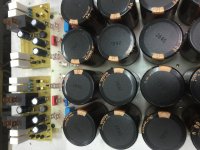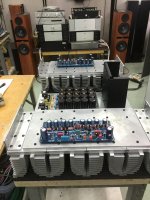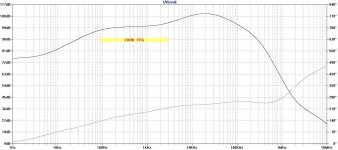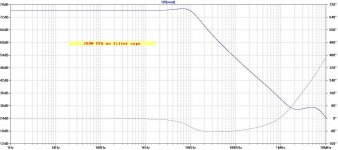bcarso, interesting insight. That's useful to me since I've been working on an amplifier that doesn't have good crosstalk ratings, but exhibits 0 auditory indication that the two channels are anything but inaudible with crosstalk. In fact it sounds better than most amplifiers, but it has a little more distortion than some think is good.
Passing my knowledge to the non-believers:
Listen to a stereo system and adjust your seperation control to go from widest separation and then towards mono. As you go towards mono, not only the center gets more focused in the middle between speakers but many sounds start to dissappear. How does that happen? Phase between music sisgnal on L and R channel gets partially cancelled out as you combine them into mono.
With this in mind..... the greater details found in stereo and the subtle details give more depth or space to the sound. As you go to mono--- as channel separation decreases--- the whole sound stage becomes more narrow and flat.
Go back and forth and you will quickly learn the affect of channel seperations importance to high-end music reproduction.
THx-RNMarsh
Listen to a stereo system and adjust your seperation control to go from widest separation and then towards mono. As you go towards mono, not only the center gets more focused in the middle between speakers but many sounds start to dissappear. How does that happen? Phase between music sisgnal on L and R channel gets partially cancelled out as you combine them into mono.
With this in mind..... the greater details found in stereo and the subtle details give more depth or space to the sound. As you go to mono--- as channel separation decreases--- the whole sound stage becomes more narrow and flat.
Go back and forth and you will quickly learn the affect of channel seperations importance to high-end music reproduction.
THx-RNMarsh
That's not quite been my experience.I'm pretty sure that the electronics for adequate fidelity isn't anywhere near the first order limitation in home recorded music reproduction
So are you going to contribute around here, or just tell everyone off all the time?
Not leading people astray has its value.
OK. Are you done with that useless diatribe? [no further useless knee-jerk diatribe response is needed, thank you]
This whole question came about during the VFA vs CFA discussion about what are the differences. It was pointed out how 'inferior' the psrr is of the CFA compared to VFA (high gnfb). As JC and myself and others have noted more than once, it doesnt really matter a lot if you have super high PSRR. You can get the desired end result several ways.
THx-RNMarsh
Richard, this is PSRR of the 200W CFA. I don't see to big difference from VFA.
Damir
Attachments
95dB at 50/60Hz and greater to over 100KHz. Those numbers from a CFA should put the PSRR debate to rest for CFA. It will work very well IMO.
I hope we get X-talk build as good as well. Your distortion and slew rate and noise are all excellent. But also OPS isolation backward.
I am looking forward to hearing them with the new JBL M2 Master Reference Monitors.
The amp build in progress --


THx-RNMarsh
I hope we get X-talk build as good as well. Your distortion and slew rate and noise are all excellent. But also OPS isolation backward.
I am looking forward to hearing them with the new JBL M2 Master Reference Monitors.
The amp build in progress --


THx-RNMarsh
Last edited:
We disagree again, the phase relationship is fixed not random in the simplest case the spectra of a pulse train (highly likely considering dimmers, etc.) definitely easily differentiated from noise.
Scott
We don't just disagree on this one you're wrong. You get multiple harmonics in each critical band. So the perception of that is as noise not a group of sine waves. The high pass action of the coupling mechanism kills the low frequencies that you would perceive as a buzz.
Now as to your system having no noise that is about ambient noise level and threshold of perception along with your listening level.
As is clear from Fletcher Munson when you listen to music at a level different than the performance level there is a change in the perception of tonality.
Your listening habits are not universal and thus your experience may not apply to others.
ES
Last edited:
And what if the transformer has a shield between primary and secondary?
That helps a lot even if left unconnected to anywhere. But it does not reduce coupling to the core. So if the transformer is mounted to a metal chassis there still can be issues. Best to identify which lead has the most capacitance to the core and connect that lead to the neutral. Then use an insulator when mounting the transformer.
This is one of the bits of silliness prevalent in audio mags---the valuation of minimal crosstalk as somehow translating into better imaging. What rubbish! The threshold of localization as a sound coming from one of a stereo pair of loudspeakers, as coming entirely from that one channel is...wait for it...a level difference of 13dB! AT BEST (and absent any time delay effects, which are far more important if present). And this is before we consider intentional cross-feeding, which of course makes crosstalk measurements of a conventional sort ludicrously irrelevant.
That is why vinyl can produce such a great sound stage, despite a channel separation of about 30dB. On a great day ;-)
Jan
the affect of X-Talk I just gave is not the same issue as image position. It may take 13 dB for a complete subjective change to one channel. However, a much smaller amount in image shift and dB is detectable. Nothing to do with x-talk and info cancellation.
THx-RNMarsh
THx-RNMarsh
the affect of X-Talk I just gave is not the same issue as image position. It may take 13 dB for a complete subjective change to one channel. However, a much smaller amount in image shift and dB is detectable. Nothing to do with x-talk and info cancellation.
THx-RNMarsh
Yes a smaller amount is detectable, but that does not invalidate the observation (!) that with a < 30dB channel separation systems excellent sound stage and image positioning can be obtained. That however DOES invalidate the view that you need very high channel separation to get good soundstage and positioning.
The remaining question then becomes: why do we need such very high channel separation figures anyway??
Jan
Last edited:
I have been thinking about audio project names
how about AFA - Adequate Fidelity Amplifier?
really grabs the imagination doesn't it?
or JAA - Just Another Amp?
https://www.youtube.com/watch?v=pD56S7uPQyY
Yes that, and PB system channel intrinsic noise needs to be coincident too for pinpoint centre and depth imaging.
Recording system also.
Dan.
Is that like the intrinsic field that created Dr. Manhatten?
Good soundstage and positioning is not optimal soundstage and positioning.Yes a smaller amount is detectable, but that does not invalidate the observation (!) that with a < 30dB channel separation systems excellent sound stage and image positioning can be obtained. That however DOES invalidate the view that you need very high channel separation to get good soundstage and positioning.
The remaining question then becomes: why do we need such very high channel separation figures anyway??
Jan
Crosstalk widens and shifts side sound sources, add frequency/phase dependence of the crosstalk and the result is a sorry mess, ie loss of depth position and lateral position resolution.
Further, circuit noise of the two channels is not correlated, and crosstalk adds 'noisy' noise to each channel, further diminishing positional information stability and accuracy, and ruining 3D imaging.
So, it comes down to how much messy monoing you are prepared to tolerate.
Granted, there are tons of recordings in glorious mono that sound great, and reveal great depth information.
It could be argued that programme noise that is identical in each PB channel/speaker contains essentially zero depth information, and is readily ignored by the ear.
Crosstalk signal is a depth information containing signal, readily discriminated by the trained ear and presents as noisy and interfering programme information.
I have a mono radio which is very suitable for the bathroom, but for music enjoyment any crosstalk is savagely deleterious ime.
Making system noise correlated takes 3D imaging precision, timbre and frequency extension to the next level, and renders embedded program noise innocuous.
Dan.
95dB at 50/60Hz and greater to over 100KHz. Those numbers from a CFA should put the PSRR debate to rest for CFA. It will work very well IMO.
I am looking forward to hearing them with the new JBL M2 Master Reference Monitors.
The amp build in progress --
THx-RNMarsh
Schematic? I see an RC for the large cap banks, what values? Bypassed by a cap 1/3 the size of the RC cap? 10ohm & ?
PHE426 input cap? They're much better with a bypass. And ironically I doubt all those 220uf caps are better with ceramic bypass caps. Just guesses!
It is difficult to imagine what this sentence might mean, but it appears to say that the noise in each channel should be correlated with the noise in the other channel. If so, all that gives is a central noise source in the stereo image. I would have thought that highly uncorrelated noise would be preferable and easier to ignore.Max Headroom said:Making system noise correlated takes 3D imaging precision, timbre and frequency extension to the next level, and renders embedded program noise innocuous.
That helps a lot even if left unconnected to anywhere. But it does not reduce coupling to the core. So if the transformer is mounted to a metal chassis there still can be issues. Best to identify which lead has the most capacitance to the core and connect that lead to the neutral. Then use an insulator when mounting the transformer.
Hm, I'll do a field test and get back to you.
- Status
- Not open for further replies.
- Home
- Member Areas
- The Lounge
- John Curl's Blowtorch preamplifier part II

